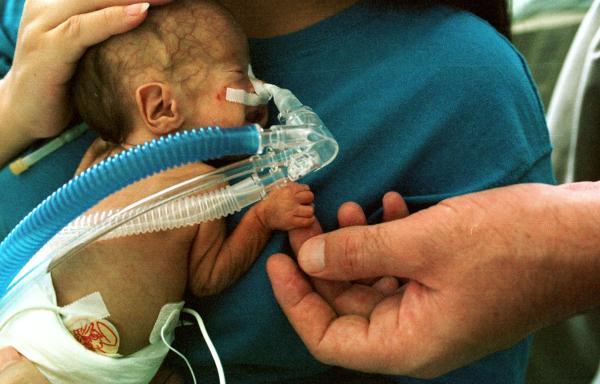What could sound more revolutionary than a “cancer moonshot?” Or, the recent “groundbreaking” message heard around the world of a company claiming a “complete cure for cancer” in a year? Then, there is the whole anti-aging field overpromising a fountain of youth. Kaiser Health News reported on a leading scientist’s incentive to hype and how the field is induced to do so early and often, despite the status of the research (see here). And, though such advancement in any of these disciplines would be welcomed, what actually is transformative and more rapidly achievable starts less on the public stage and more at the patient’s bedside.
When solutions to problems we have are the focus, expedited innovation is possible. Look no further than this study just reported in Science: “Binodal, wireless epidermal electronic systems with in-sensor analytics for neonatal intensive care.” Yes, it is riddled with jargon, but unpacking it further will demonstrate how this development will considerably progress patient care and have a rippling effect for expanded uses. Today and tomorrow. Not some unimaginable time in the distant future (maybe).
This study recounts the early promising data after a new technology for continuous neonatal monitoring has begun implementation. To understand its utility, first, a little background on the limitations of existing monitoring systems on the extreme premature infant.
Premature infants are tiny and can range significantly. Their skin is immature and depending on the extent of prematurity profoundly fragile. Adhesives from present day wired monitoring often strip and scar the skin. Some babies this young require months in the neonatal intensive care unit (NICU), so proper wound care becomes essential. Shifting positions of an infant weighing sometimes less than 1000 grams adorned with this elaborate external, often invasive paraphernalia can be cumbersome, wrought with risk, tedious, labor-intensive and for these reasons and more delay care. Think about how challenging getting an imaging study can be on such a patient and even interpreting the diagnosis when such artifacts obstruct visualization. The equipment itself can serve as a barrier to much needed bonding between parent and child, contributing to worry and additional stress. And, due to the mobility and body size of this population and their inability to follow directions, devices often fall off (e.g. from kicking) and require multiple caregiving hands to hold in proper alignment to acquire the needed information or prevent untoward effects.
But, the continuous monitoring in such critical patients is crucial to facilitating their survival. Treatment and management decisions are constantly adapted to the high variability and volatility. So, despite how problematic some of it is, the alternative is unimaginable.
This brings us to the work featured in Science detailing a lighter weight, time-synchronized, noninvasive, battery-free vitals monitoring system that is ultrathin “skin-like,” gentle and can accommodate down to the most premature of infants. It is made up of only two sensors whose removal is apparently not traumatic, one fashioned to the chest and the other to the foot - liberating the patient of extraneous wires and equipment. “This binodal system captures and continuously transmits ECG, PPG [photoplethysmograms], and (from each device) skin temperature data, yielding measurements of heart rate, heart rate variability, respiration rate, blood oxygenation, and pulse arrival time as a surrogate of systolic blood pressure.” There also appears to be greater compatibility with the materials and medical imaging.
Now, this feat of engineering involved the confluence of physicists, engineers, and a host of disciplines. It addresses an unmet need that holds promise well beyond the NICU throughout the entire health system - and, inevitably other fields entirely. If the feedback continues to demonstrate clinical accuracy to the standard of care, then it helps solidify the foundation of innovation and could serve even further to free up time, the most precious commodity of a busy practitioner, to devote to therapeutic intervention. The impact could be vast.
Those on the frontlines of healthcare have a ringside seat to humanity’s greatest struggles. All too often largely ignored, instead, their insight into suffering should be harnessed. Only then, will the impossible be possible. For more examples, review “The Big Ideas In Medicine Often Come From The Front Lines, Not The Ivory Tower.”




